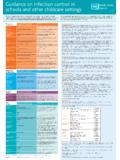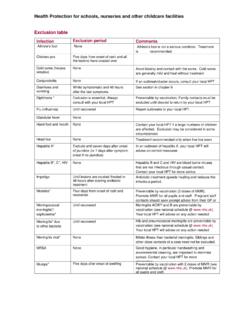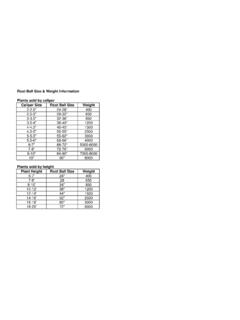Transcription of Infection (MDRO/CDI) Module
1 January 2022 12-1 Multidrug-Resistant Organism & Clostridioides difficile Infection (MDRO/CDI) Module Table of Contents Background: 2 Table 1. Core and Supplemental Reporting Choices for MDRO and CDI Module 3 Section I: Core Reporting 5 Laboratory-Identified (LabID) Event Reporting 5 1A: MDRO LabID Event Reporting 6 Figure 1. MDRO Test Result Algorithm for All Specimens Laboratory-Identified (LabID) Events 9 Figure 2. MDRO Test Result Algorithm for Blood Specimens Only Laboratory-Identified (LabID) Events 10 Table 2: Reporting Options for the MDRO Module (non-CDI) 11 MDRO Data Analysis: 16 1B: Clostridioides difficile (C. difficile) LabID Event Reporting 22 Figure 3. C. difficile Test Result Algorithm for Laboratory Identified (LabID) Events 23 Table 3: Reporting Options for C.
2 Difficile (CDiff) LabID Event 24 C. Difficile (CDI) Data Analysis: 28 Table 4: Measures Delivered to CMS For Facilities Participating in Quality Reporting Programs MRSA Bloodstream Infection and C. difficile LabID Events 35 Infection Surveillance Reporting 35 2A. MDRO Infection Surveillance Reporting 36 2B. Clostridioides difficile Infection Surveillance Reporting 37 Section II. Supplemental Reporting 39 1. Prevention Process Measures Surveillance 39 2. Active Surveillance Testing Outcome Measures 43 Appendix 1. Guidance for Handling MDRO and CDI Module Infection Surveillance and LabID Event Reporting When Also Following Other NHSN Modules 46 Appendix 2: FacWideIN Denominator Counts 48 Appendix 3: Differentiating Between LabID Event and Infection Surveillance 52 January 2022 MDRO & CDI Module 12-2 Background: Methicillin-resistant Staphylococcus aureus (MRSA), vancomycin-resistant Enterococcus spp.
3 (VRE), and certain gram-negative bacilli have increased in prevalence in hospitals over the last three decades and have important implications for patient safety. There is concern about these multidrug-resistant organisms (MDROs), as options for treating patients with these infections are often extremely limited, and MDRO infections are associated with increased lengths of stay, costs, and mortality. Many of these traits have also been observed for Clostridioides difficile Infection (CDI). The Healthcare Infection Control Practices Advisory Committee (HICPAC) has approved guidelines for the control of MDROs. 1 These guidelines are available at ). The MDRO and C. difficile Module of NHSN provides a tool to assist facilities in meeting some of the criteria outlined in the guidelines. In addition, many of the metrics used in this Module are consistent with Recommendations for Metrics for Multidrug-Resistant Organisms in Healthcare Settings: SHEA/HICPAC Position Paper.
4 2 Clostridioides difficile (C. difficile) is responsible for a spectrum of C. difficile infections (CDI), including uncomplicated diarrhea, pseudomembranous colitis, and toxic megacolon, which can, in some instances, lead to sepsis and death. Although CDI represents a subset of gastrointestinal tract infections in the current CDC definitions for HAIs, specific standard definitions for CDI 3 should be incorporated to obtain a more complete understanding of how C. difficile is being transmitted in a healthcare facility. As outlined in the HICPAC guideline1, these MDRO and C. difficile pathogens may require specialized monitoring to evaluate if intensified Infection control efforts are required to reduce the occurrence of these organisms and related infections. The goal of this Module is to provide a mechanism for facilities to report and analyze data that will inform Infection prevention professionals of the impact of targeted prevention efforts.
5 This Module contains two core reporting options for MDRO and C. difficile Laboratory Identified (LabID) Event reporting and Infection Surveillance reporting. These reporting options function as two separate and independent reporting methods - one focused on laboratory-based reporting and the second on Infection criteria-based surveillance reporting. Reporting options are summarized in Table 1. Participants may choose either one or both of these reporting options and then may also choose to participate in any of the supplemental monitoring methods described in Table 1. See Appendix 3: Differentiating Between LabID Event and Infection Surveillance for key differences between the two options. January 2022 MDRO & CDI Module 12-3 Table 1. Core and Supplemental Reporting Choices for MDRO and CDI Module Reporting Choices MDRO CDI MRSA or MRSA/MSSA VRE CephR-Klebsiella, CRE (E.)
6 Coli, Enterobacter, Klebsiella), Acinetobacter spp. (MDR) C. difficile Core Method Method Method Method Proxy Infection Measures LabID Event Choose 1 organism A, B, C, D A, B, C, D A, B, C, D A, B, C AND/OR Infection Surveillance Choose 1 organism A, B A, B A, B A, B Supplemental Method Method Method Method Prevention Process Measures Options: Hand Hygiene Adherence Gown and Gloves Use Adherence Active Surveillance Testing (AST) Adherence B B B B B B B B N/A B B N/A AST Outcome Measures Incident and Prevalent Cases using AST B B N/A N/A N/A not available or contraindicated No surveillance for C. difficile will be performed in Neonatal Intensive Care Units (NICU), Specialty Care nurseries (SCN), babies in LDRP (Labor, Delivery, Recovery, and Post-partum), well-baby nurseries , or well-baby clinics. If conducting facility-wide monitoring (Method C), the denominator counts (admissions, patient-days and encounters) for these locations must be removed.
7 January 2022 MDRO & CDI Module 12-4 Reporting Method (must choose to monitor by LabID Event or Infection Surveillance reporting before supplemental methods can also be used for monitoring): A: Facility-wide by location. Report for each location separately and cover all locations in a facility. This reporting method requires the most effort but provides the most detail for local and national statistical data. B: Selected locations within the facility (1 or more). Report separately for one or more specific locations within a facility. This includes reporting individual events and denominator data for each of the selected locations. This reporting method is ideal for use in targeted prevention programs. Note: MDRO Blood Specimens Only monitoring is the only MDRO LabID event reporting option for IRF, ED, and 24-hr Observation locations.
8 For Inpatient locations other than IRF, ED, and 24-hr Observation (examples: IPF, Medical, Surgical, etc.) All Specimens monitoring is the only MDRO LabID event reporting option. C: Overall facility-wide. Report individual LabID events from each inpatient location and total denominator counts for the entire facility. Options include: (1) Overall Facility-wide Inpatient (FacWideIN) to cover all inpatient locations where denominator data are collected. When using FacWideIN reporting, facilities must also include location specific reporting for outpatient emergency department (adult and pediatric) and 24-hr Observation location(s). Note: When following FacWideIN, facilities must include denominators for all inpatient locations physically located in the hospital Totals reported should not include facilities affiliated with the hospital that are enrolled separately in NHSN. Additionally, separate denominator data will be required to capture encounters for each mapped emergency department and 24-hr observation location.
9 (2) Overall Facility-wide Outpatient (FacWideOUT) to cover all outpatient locations affiliated with the facility where encounters are captured. Facilities may choose to monitor FacWideOUT in addition to FacWideIN monitoring. D: Overall facility-wide: Blood Specimens Only. This method is available for MDRO LabID Events only and targets the most invasive events. Report individual LabID events from each inpatient location and total denominator counts for the entire facility. Options include: (1) Overall Facility-wide Inpatient (FacWideIN) to cover all inpatient locations. Using this option, facilities must also include location specific reporting for each outpatient emergency department (specifically, adult and pediatric) and 24-hr observation location(s). Note: When following FacWideIN, facilities must enter denominators for all inpatient locations physically located in the hospital, as well as denominators for all inpatient locations minus any inpatient rehabilitation facility (IRF) and inpatient psychiatric facility (IPF) locations with separate January 2022 MDRO & CDI Module 12-5 CCNs.
10 Totals reported should not include facilities affiliated with the hospital that are enrolled separately in NHSN. Additionally, separate denominator data will be required to capture encounters for each mapped emergency department and 24-hr observation location. (2) Overall Facility-wide Outpatient (FacWideOUT) to cover all outpatient locations affiliated with the facility. Facilities may choose to monitor FacWideOUT in addition to FacWideIN monitoring. Section I: Core Reporting Laboratory-Identified (LabID) Event Reporting Introduction: LabID Event reporting option allows laboratory testing data to be used without clinical evaluation of the patient, and therefore is a much less labor-intensive method to track MDROs and C. difficile. These provide proxy Infection measures of MDRO and/or C. difficile healthcare acquisition, exposure burden, and Infection burden based almost exclusively on laboratory data and limited admission date data, including patient care location.













